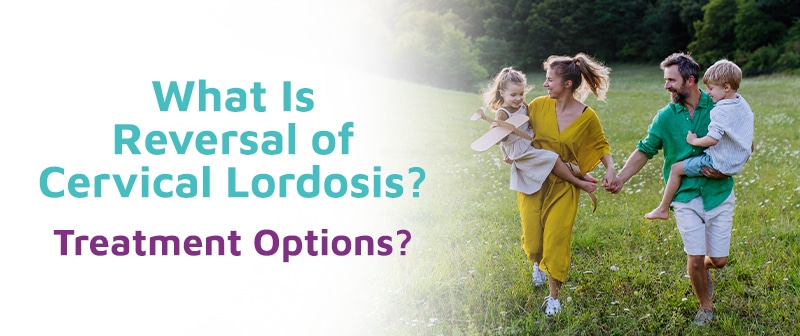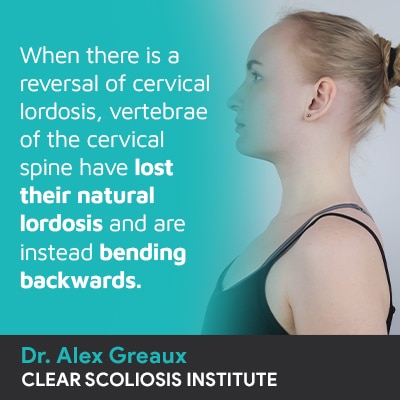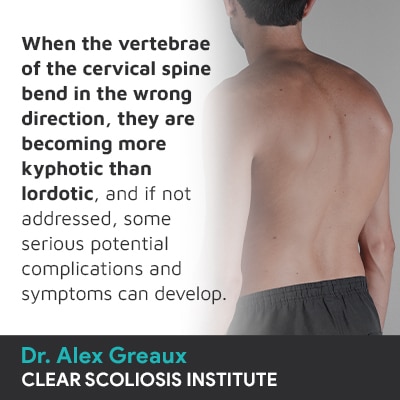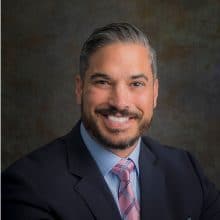
Maintaining a healthy range of cervical lordosis is important. Each spinal section has a role to play in maintaining overall spinal health and function; the cervical spine has the added responsibility of supporting the head and acting as the bridge between the brain and the rest of the body. Continue reading to learn more about the cervical spine’s natural/healthy curve, and what happens when it’s lost.
The vertebrae of the cervical spine bend inwards in a soft ‘C’ shape, known as cervical lordosis; if there is a reversal of cervical lordosis, the vertebrae of the cervical spine bend in the wrong direction, and treatment is largely shaped by severity and cause.
When it comes to the cervical spine experiencing a loss of its natural lordosis, the importance of its healthy curve has to be understood, so let’s start there.
In a healthy spine, its natural curves are in place, and this is important because when the spine’s healthy curves are in place, its vertebrae (bones of the spine) are in a straight and neutral alignment, as they should be.
When an unhealthy spinal curve develops, it’s replacing a healthy one, and this means some vertebral bodies have become unnaturally tilted and/or straight, shifting them out of alignment with the rest of the spine, and this doesn’t just affect the spinal section it occurs in; it disrupts the biomechanics of the entire spine as each spinal curve is affected by the health of the others.
There are three main sections of the spine: the cervical spine (neck), thoracic spine (middle/upper back), and the lumbar spine (lower back).
Each spinal section has its own unique roles, characteristics, and curvature type, and as long as its curvature size falls within a healthy range, its vertebrae are aligned, but if a curvature becomes under- or over-pronounced, problems can occur.
The cervical spine consists of the spine’s first seven vertebral bodies (C1 to C7), and as mentioned, the cervical spine has to support the weight of the head and is particularly important because as the bridge between the brain and the rest of the body, it facilitates brain-body communication.
Remember, a healthy spine doesn't just allow us to remain upright, practice healthy posture, protect internal organs, and engage in a range of flexible movements, the spinal cord within also partners with the brain to form the central nervous system (CNS).
A healthy cervical spine has what’s called lordosis, and this is a spinal curvature type that bends forward, resembling a standard ‘C’ shape; the opposite curvature type is known as kyphosis, and this type of spinal curve bends backward in a reverse ‘C’ shape.
If the neck has a healthy range of cervical lordosis, it can optimally support the weight of the head, has a wide range of motion, and allows for signals to pass between the brain and the parts/systems of the body.
Now that we have a good understanding of why a healthy cervical spine is important, let’s talk about what happens when the cervical spine’s lordosis doesn’t fall within a healthy range.

A healthy range of cervical lordosis falls between 31 and 40 degrees, and if a person’s lordosis doesn’t fall within this healthy range, the neck’s natural curve is lost, causing the cervical spine to become excessively straight.
When the neck’s natural and healthy curve becomes excessively flat, this can lead to what’s referred to as military neck, due to how it resembles soldiers rigidly standing at attention, and/or forward head posture.
Hyporlordosis can involve a loss of the neck’s healthy lordosis, and if the vertebrae of the cervical spine are bending in the wrong direction, this is called a reverse curve and/or a reversal of cervical lordosis.
So what are some symptoms associated with a reversal of cervical lordosis?
When the vertebrae of the cervical spine bend in the wrong direction, they are becoming more kyphotic than lordotic, and if not addressed, some serious potential complications and symptoms can develop.
As is the case with the majority of spinal conditions, symptoms are shaped by a number of important patient and condition variables: patient age and overall health, underlying cause, and severity.

When it comes to range of motion, while the effects of that loss are largely felt in the cervical spine and its immediate surroundings, it can also affect the lower body’s range of motion; sometimes, when there is a loss of the cervical spine’s healthy curve, the lumbar spine can add a compensatory curve in an attempt to counteract the uneven forces of the unnatural spinal curve above.
Now that we’ve defined the condition, and some of its common symptoms, let’s talk about how a loss of cervical lordosis can be treated.
As a CLEAR-certified scoliosis chiropractor, I follow the CLEAR Scoliosis Institute treatment approach and protocols.
A conservative chiropractic-centered treatment approach offers patients an alternative to invasive spinal surgery and integrates multiple condition-specific treatment disciplines so treatment plans can be fully customized.
The ultimate goal of restoring a patient’s cervical lordosis is to improve the neck’s range of motion and flexibility, strengthen the cervical spine’s surrounding muscles so the neck receives more support, and the spine’s biomechanics are improved.
In order to treat a loss of cervical lordosis effectively, the condition’s underlying cause has to be addressed, and there are different causes to consider.
If the loss of lordosis is related to chronic poor posture and/or carrying excess weight, these are lifestyle factors that need to be proactively addressed.
If the spine has lost its natural lordosis due to a spinal injury/trauma, the injury has to be addressed to make improvements to spinal health, function, and strength.
If the presence of a spinal condition like hypolordosis or scoliosis is the cause of a loss of cervical lordosis, the underlying spinal condition has to be the focus of treatment, and this involves impacting conditions on a structural level.
If a structural condition is impacted on a structural level, its underlying nature is being addressed, which can improve symptoms as the spine’s alignment is improved.
Through condition-specific chiropractic care that involves a number of chiropractic techniques and manual adjustments, I attempt to adjust the position of the unnatural curve’s vertebrae so they are more aligned with the rest of the spine.
Physical therapy and a number of therapeutic exercises can help relax and strengthen the neck’s surrounding muscles so the spine is optimally supported, posture and coordination are improved, and in addition, certain exercises are also known to stimulate specific areas of the brain for improved brain-body communication
In addition, spinal weights can help with neurological retraining, and part of restoring a healthy degree of cervical lordosis can involve soft-tissue remodeling so the neck’s ligaments can be relaxed and rehabilitated to better support the cervical spine.
The way the spine responds to treatment has to be monitored carefully so treatment plans can be adjusted accordingly, and by performing X-rays both at the beginning and end of treatment, I can ensure the spine has been impacted on a structural level for long-term sustainable treatment results.
If the cervical spine loses its natural lordosis, this can involve a reversal of cervical lordosis as the vertebrae of the cervical spine bend backwards, instead of forwards as they’re supposed to; this makes the cervical spine more kyphotic than lordotic and can cause a number of issues, especially if left untreated.
If a patient’s cervical spine becomes excessively straight, this can disrupt its ability to move flexibly, properly support the weight of the head, and pass signals from the brain to the rest of the body.
Here at the CLEAR Scoliosis Institute, I have experience treating a wide range of spinal conditions, a reversal of cervical lordosis included.
When it comes to restoring a healthy degree of lordosis to the cervical spine, what caused the loss of cervical lordosis has to be addressed.
Treatment options can include lifestyle guidance and improvement, chiropractic care that works towards repositioning the cervical spine’s vertebrae that have become excessively straight, and physical therapy/a number of therapeutic exercises can help increase the cervical spine’s strength and flexibility, surrounding muscle strength and flexibility, improve posture and brain-body communication.
When it comes to preventing a loss of cervical lordosis, leading a healthy spine-friendly lifestyle is key: maintaining a healthy weight, activity level, practicing good posture, understanding the ergonomics of heavy lifting, and avoiding looking down at devices, and straining the neck, for long periods of time.

CLEAR provides a unique and innovative way of understanding scoliosis. Sign up to receive facts and information you won’t find anywhere else.
